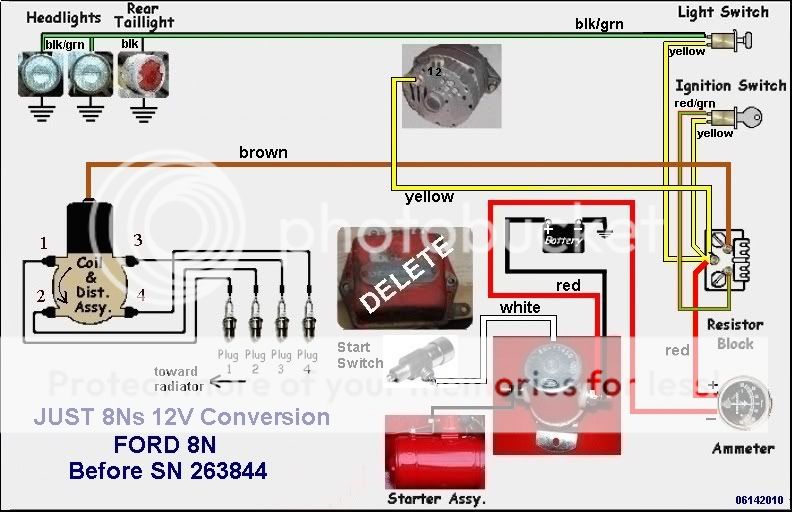You should upgrade or use an alternative browser.
- Thread starter Eriklane
- Start date
rash your sketch & do it like this:(quoted from post at 10:20:02 01/08/13) You guys...on one hand, these meters don't help much...but, I do want it wired to be like how it was stock...
So should I move the alternator wire to directly hook to the battery(I sense a huge shower of sparks)...I'm so bad at this stuff...

teddy52food
Well-known Member
ope you are not still looking at your first posted diagram. Don't. At least 3 conditions can exist here. 1)The alternator is doing nothing (belt broke), so the battery has to power all loads (ignition, lights....), so current (conventional) leaves + batt post, to ammeter (-), through ammeter (-) to (+) {running current through it in this direction makes it indicate a neg or discharge}, and on to & through the load & out opposite load terminal through chassis & back to battery neg(_) termimal, this completing the loop. 2) New belt on alternator, but battery is dead as a door-nail, so you use a jump box to start tractor. Alternator outputting current, flows to junction block, where the alternator current value splits, with some part supplying loads (ign, lights...) AND some part finding a path through the ammeter and on to the battery{current is passing through ammeter from (+) to (-)and on into battery(+) post {running current through it in this direction makes it indicate a positive or charge}. Thus the ammeter indicates the amount of battery charge current. On a dead or near dead battery, this will be large, but as battery nears full charge, the reading will trickle off to nearly zero. 3) As battery reaches full charge, the alternator will be providing current for the loads and the in/out battery current is virtually zero. So we have three cases, 1) battery supplying all loads, 2)alternator both charging battery & supplying all loads, and 3) battery loafing & alternator supplying all loads.(quoted from post at 08:59:31 01/09/13) So back to what baffles me-given a single alt wire going to a junction block out of which comes a wire that runs to the ammeter + side, and then the - side goes to the solenoid, and from there, to the battery + side, if current flows from the alternator, and from the battery, how does that work? How does the battery charge if current flows out of the + battery post?
Very interesting, and a good learning exper. for me...thing is, new battery almost dead when I tried to start...hadn't run it in months, but the 'old' 'bad' battery almost always at least would give me a few good rumpas...so, makes me wonder if the last time I drove it, late summer, the alt was going and thus, I drained my new battery...will check on that. Thanks for the input.
Update-got er wired up - Yellow Alt, yellow IGN, red Ammeter(+) and wire to lights, all in one wire nut. Hit starter with key off and ammeter goes down. Pull light switch (I forget if I had key on or off) and ammeter goes up. Sound normal? (All those with motor not running).
Can I safely test my alternator, or do I have to take it to the parts store for a test?
)maybe you didn't wire it the way you think you did, 2)alternator bad, 3)left key or lights on when last used, 4) maybe battery not really dead....hydrometer?. Bad, dirty, loose connection can appear to be dead battery to some folks.(quoted from post at 17:16:09 01/12/13) Typical for me. Go out to start the tractor, dead. Battery (new in summer) is dead. Hilarious.
Someone wanna offer why based on the fact that I wired it like the diagram?
I know what you're saying about the mild winters lately.
I'm only about 30 miles from you, just off M66 and M57 corner.
Shoot me an email if you want and maybe we can get together and figure it out.
Email is open on modern view.
What I'll do is take a meter to it with key off and see if I'm getting power to the coil. I have a sneaky that my new key circuit from farm store (not TSC) is letting current fly thru it all the time. It did seem to turn awful easy, despite it being new...should be a simple test.
Similar threads
- Replies
- 1
- Views
- 409
- Replies
- 7
- Views
- 593
We sell tractor parts! We have the parts you need to repair your tractor - the right parts. Our low prices and years of research make us your best choice when you need parts. Shop Online Today.
Copyright © 1997-2024 Yesterday's Tractor Co.
All Rights Reserved. Reproduction of any part of this website, including design and content, without written permission is strictly prohibited. Trade Marks and Trade Names contained and used in this Website are those of others, and are used in this Website in a descriptive sense to refer to the products of others. Use of this Web site constitutes acceptance of our User Agreement and Privacy Policy TRADEMARK DISCLAIMER: Tradenames and Trademarks referred to within Yesterday's Tractor Co. products and within the Yesterday's Tractor Co. websites are the property of their respective trademark holders. None of these trademark holders are affiliated with Yesterday's Tractor Co., our products, or our website nor are we sponsored by them. John Deere and its logos are the registered trademarks of the John Deere Corporation. Agco, Agco Allis, White, Massey Ferguson and their logos are the registered trademarks of AGCO Corporation. Case, Case-IH, Farmall, International Harvester, New Holland and their logos are registered trademarks of CNH Global N.V.
Yesterday's Tractors - Antique Tractor Headquarters
Website Accessibility Policy


